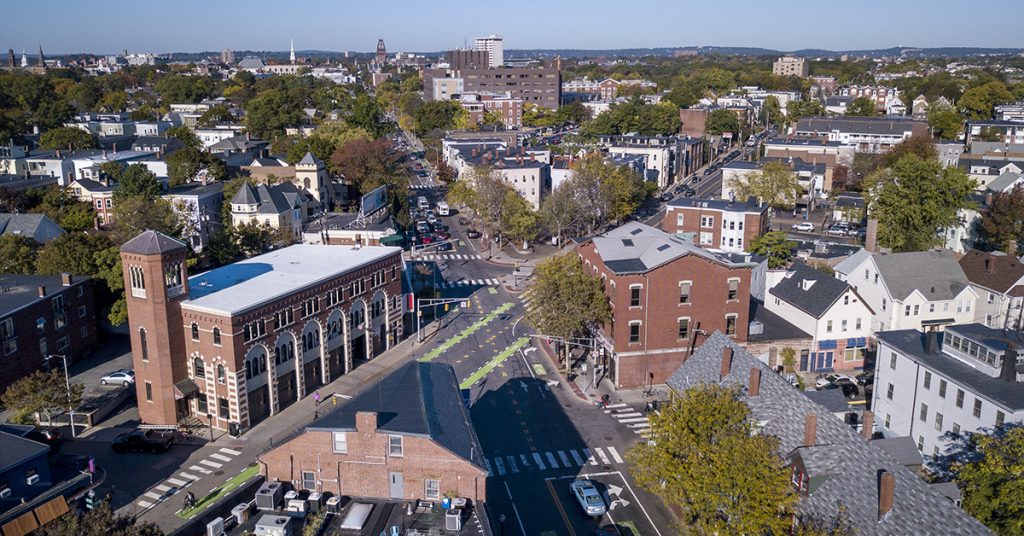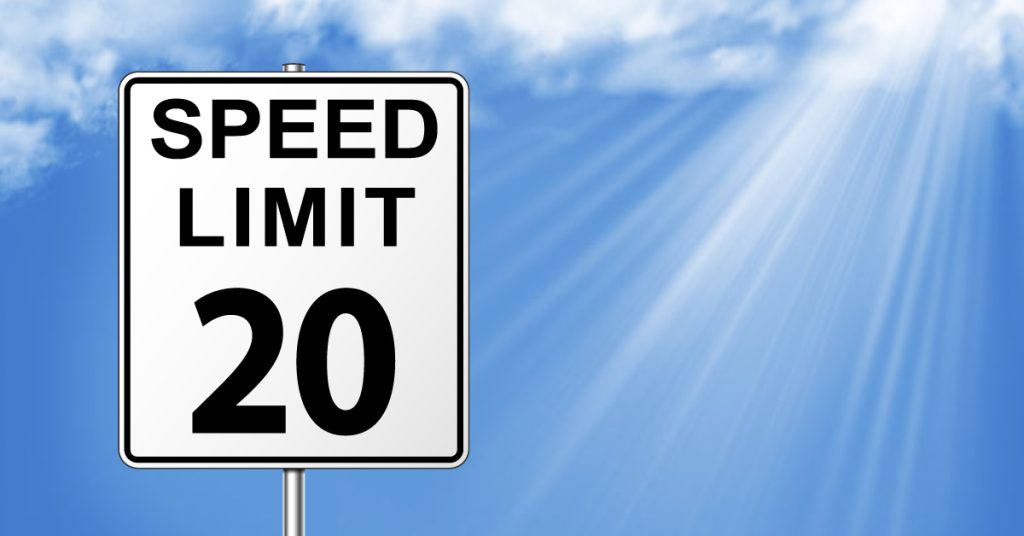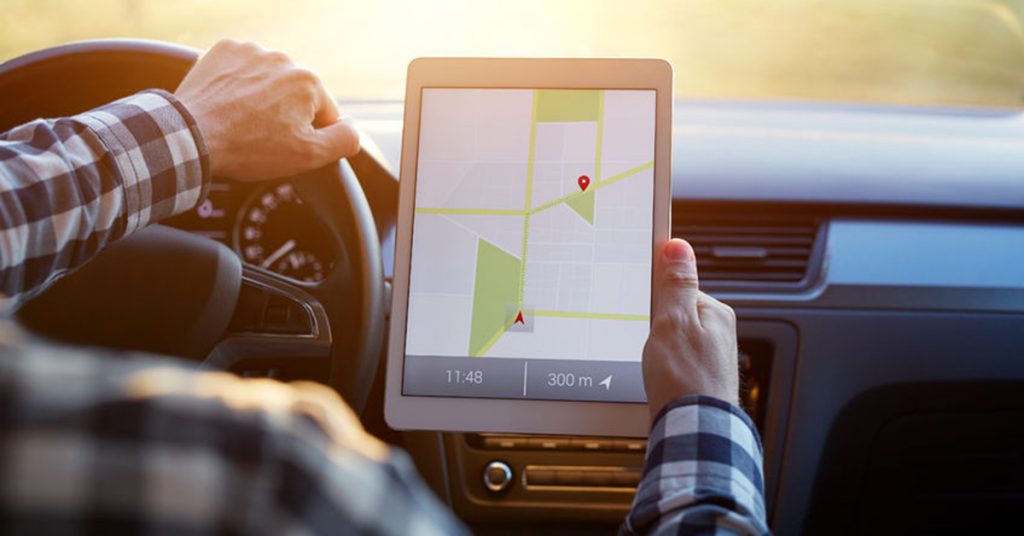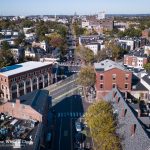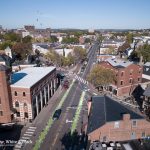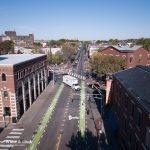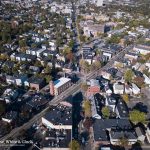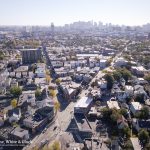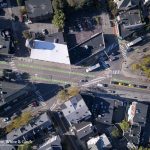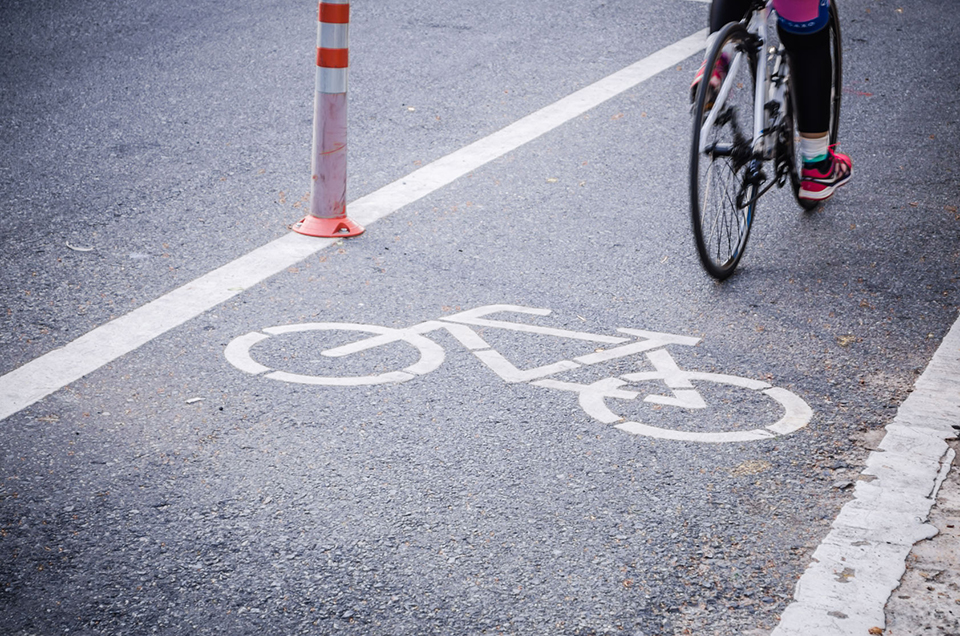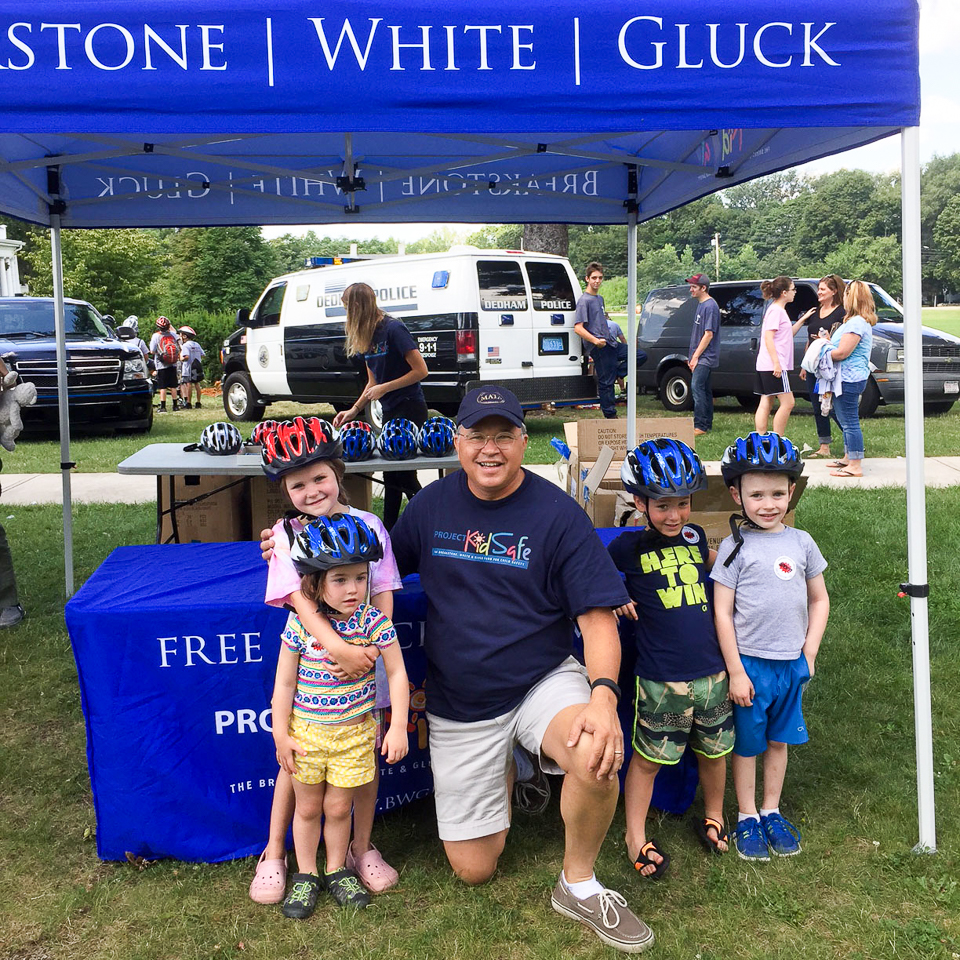Posts Tagged ‘Cambridge’
After Fatal Harvard Square Bicycle Accident, Cambridge Expands and Accelerates Plans for Protected Bike Lane Network
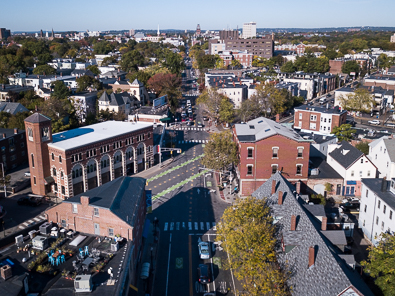
View from Inman Square, Cambridge, once ranked the top bike crash site in Massachusetts, according to MassDOT crash data. Photo: 2017, after installation of new bike lanes.
With strong encouragement from local cyclists, the Cambridge City Council voted to expand and update the Cambridge Cycling Safety Ordinance this week. The council approved the original ordinance last year, drawing national attention with an ambitious commitment to build 20 miles of protected bike lanes.
But cyclists felt there was more work to do. They recently asked the Cambridge City Council to prioritize areas for protected bike lane development, add new roads and establish a deadline for improvements.
- The Cambridge City Council approved a May 1, 2026 deadline for building out Cambridge’s network of protected bike lanes (now 22.6 miles), using either permanent construction or quick-build approaches (Source: Cambridge Bicycle Safety announcement dated October 6, 2020).
- Protected bike lanes will also be added in more areas, including Broadway, between Harvard University and Kendall Square, and Garden Street, according to according to StreetsBlog Mass.
- City councilors also voted to prioritize bike lane development in the area north of Harvard Square, directing city staff to develop a detailed plan by May 2021. Hampshire and Cambridge streets, near Inman Square, will also now move up on the work list (Source: StreetsBlog Mass).
The vote comes several weeks after a cyclist was killed in Harvard Square. In August, a large tractor-trailer struck and killed the male cyclist on Massachusetts Avenue, near Brattle Street. Just a year ago, in September 2019, another bicycle accident resulted in a female cyclist’s death in the area. A devastated family member later wrote a guest column in a local newspaper, urging the city to make safety improvements in Harvard Square.
The City of Cambridge has been studying traffic in congested Harvard Square. After the cyclist’s death in August, a city official stated Cambridge will add a separated bike lane and reduce travel lanes on Massachusetts Avenue, between the Harvard Square Kiosk and Harvard Square (Source: The Boston Herald, August 26, 2020).
Harvard Square is known for historic buildings and iconic shops, such as The Coop, the Harvard University bookstore. Adjacent to Harvard Yard and Harvard University, the square is located at the intersection of Massachusetts Avenue, Brattle Street and John F. Kennedy Street. The MBTA red line stops there and pedestrians and cyclists are in close proximity to motor vehicle traffic, buses and trucks.
Other Cambridge Bicycle Accidents
The Cambridge Bicycle Safety, a volunteer group, has led the effort for expanding protected bike lanes across the city. Its announcement noted this was the first mandatory timeline for building a bike lane network in the United States.
Safety is a leading concern for cyclists in Cambridge. Between residents and commuters, Cambridge has a high number of cyclists. When cyclists have been injured or killed in traffic accidents, many people have felt the impact. There has been a strong response in each case.
In June 2016, a 27-year-old cyclist was tragically hit and killed in a bicycle crash in Inman Square. The woman was struck by a Jeep Cherokee’s open door, then pushed into the travel lane, where she was ultimately struck by a moving dump truck, according to Wicked Local Cambridge. She was pronounced dead a short time later at Massachusetts General Hospital.
Then, in October 2016, a cyclist was fatally injured in Porter Square. The cyclist was struck by a tractor-trailer and a sedan during a morning ride. He was pronounced dead at the scene.
After these crashes, a Cambridge resident campaigned to encourage drivers to use the Dutch Reach method before exiting their vehicles. This method encourages drivers to take a full look at the road from their seat, so they do not risk “dooring” a cyclist.
As a result of his campaign, the state of Massachusetts added instruction on the Dutch Reach method to the state driver’s manual to educate drivers.
Free Legal Consultation – Boston and Cambridge Bicycle Accident Lawyers
Breakstone, White & Gluck is a Boston law firm which specializes in the representation of cyclists who have been injured by negligent drivers. Our attorneys offer more than 100 years combined experience handling all types of bicycle accidents, including truck crashes injuring cyclists, intersection bike accidents, right hook crashes and dooring. We help cyclists obtain compensation for recovery, including for medical care, lost wages and pain and suffering.
But our attorneys do more than represent cyclists. We are committed to improving safety for cyclists in the Boston area. We have long supported local cyclist clubs. And through our Project KidSafe campaign, we have donated 30,000 bicycle helmets to children across Massachusetts, including in partnership with the Cambridge Police Department. The League of American Bicyclists has honored us as a Silver-Level Bicycle Friendly Business.
If you have been injured, learn your legal rights. For a free legal consultation, call our Boston bicycle accident lawyers at 800-379-1244 or 617-723-7676. You can also use our contact form.
In the Battle for Safety, Cambridge Lowers Speed Limits to 20 MPH

Drivers, double check your speed next time you visit Cambridge. In mid-November, the city plans a slow down to 20 mph on most city-owned streets. The city says, when in doubt, go 20 mph.
The City of Cambridge announced the new 20 mph speed limit this week, a decision made in response to residents’ concerns about speeding vehicles and the risk for pedestrian accidents and injuries to cyclists. Cambridge follows Boston and Somerville in pursuing 20 mph speeds on certain city streets. Each city has a VisionZero safety campaign and is working to eliminate traffic fatalities.
Cambridge first lowered speed limits from 30 to 25 mph on most city-owned streets in December 2016. The Massachusetts Legislature granted cities and towns this authority earlier that year with passage of the Municipal Modernization Law. Specifically, communities were given the authority to lower speeds from 30 to 25 mph in locally-owned thickly settled areas.
In response, dozens of communities adopted 25 mph speed limits to reduce the risk of accidents. Few have pursued 20 mph – yet.
But according to the City of Cambridge’s announcement, the law allows communities to establish 20 mph “safety zones” in the interest of public safety. Cambridge will be installing 660 new “safety zone” signs.
The City of Somerville has also taken advantage of this provision of the law. Last we knew, the City of Boston – which was the first to pursue 25 mph, then 20 mph speeds – was still working on the issue. Here is our last update on Massachusetts speed limits (though please note: there may have been additional action since then).
Check a street: Not every street in Cambridge will be impacted. Larger streets like Brattle Street and Cambridge Street will stick with current speeds. Roads under state management – such as Memorial Drive – will not change. You can check out the map here: www.cambridgema.gov/20mph.
It’s worth noting Cambridge’s squares – including Harvard Square, Lechmere Square and Porter Square – won’t see any change. The city lowered speeds to 20 mph back in early 2018.
Cambridge’s Influence on Traffic Safety
Cambridge has been ambitious in making traffic safety improvements. In addition to lowering speeds, the city announced a new City Safety Ordinance earlier this year. The city made the commitment to add permanent separated bike lanes whenever it reconstructs roads identified in the Cambridge Bicycle Plan. With full build out, this would give the city an impressive 20 miles of protected bike lanes. Cambridge Bicycle Safety, a local group, said this could reduce 40 percent of Cambridge bicycle accidents, the one which occur outside intersections.
The city, while committed, does concede there may be cases when these bike lanes aren’t possible due to road conditions.
The bottom line is Cambridge has such a strong influence on transportation in the Boston region, just by virtue of its geography. It borders Somerville, Boston, Arlington, Belmont and Watertown. And because it’s one of the largest cities in Massachusetts, its work to promote safety will be watched across the state and nationally.
Free Legal Consultation – Boston Pedestrian Car Accident Lawyers
Breakstone, White & Gluck has represented accident victims in Boston, Cambridge and across Massachusetts since 1992. Our attorneys are dedicated to our clients and our results. We provide the prompt and thorough investigation required after pedestrian car accidents and bicycle crashes.
If you have been injured by a driver, we offer a free legal consultation to advise you on whether you may pursue a financial claim for your injuries and other losses. Consult one of our personal injury attorneys today at 800-379-1244 or 617-723-7676. You can also use our contact form.
Massachusetts Communities Fight Back Against Traffic Detour Apps

Local communities are restricting road use to stop the flood of drivers who use Waze and other traffic apps.
Commuting is a battle in Massachusetts, full of frustrations and hazards. But residents, communities and lawmakers continue to fight back to improve safety.
On Monday, the state House of Representatives considered a controversial bill proposing new fines for jaywalking and jaywalking while distracted (or as The Boston Globe writes, “Jay-texters”). Meanwhile, WBZ reports communities are closing off roads in response to traffic apps such as Waze and Google Maps.
Jaywalking Bill. On Beacon Hill, Rep. Colleen M. Garry, D-Dracut, has proposed Bill H.1834, which would allow cities and towns to impose stronger penalties against jaywalking. The current penalty is $1, which isn’t much of a deterrent. But this new bill proposes:
- Jaywalkers may be fined $25 for a first offense, $50 for a second offense and $100 for a third or subsequent offense.
- The proposal calls for new and increased fines for pedestrians who violate the jaywalking law and are using mobile devices or earphones. Using a mobile device will increase the fine to $50 for a first offense, $100 for a second offense and $200 for a third or subsequent offense.
Massachusetts is not the only state considering action. In New York, the State Assembly passed a law for New York City to study the problem. As of last month, the City of Honolulu began ticketing pedestrians who are texting or reading from a cell phone. The price? Up to $99 per violation.
While pedestrian texting bans are new, 47 states and Washington D.C. now have laws which ban texting while driving. Puerto Rico, Guam and the U.S. Virgin Islands also have bans. Massachusetts passed its texting while driving ban in 2010.
This is a controversial topic. We will be among those watching the State House this week.
Traffic Detour Apps. WBZ reported on Monday that drivers are continuing to make use of apps such as Waze and Google Maps, which help them find the shortest route (Note: Waze was actually acquired by Google in 2013). But regardless of the specific brand name, police departments say these apps are a safety issue because they change traffic flow and draw large amounts of traffic to residential roads.
Now cities, such as Medford, Cambridge, Brookline and Belmont have taken action, by closing off roads or posting no turn signs.
Here are a few notes for your commute:
- In October, Medford Police announced Bracket Street at Elm Street is residents only on weekdays from 7 a.m. to 9 a.m. and 4 p.m. to 6 p.m.
- Belmont has installed no right turn signs off Brighton Street.
- Brookline has restricted access to several roads off Clyde Street.
- In Cambridge, Fresh Pond Parkway is also closed to through traffic.
These are two stories for every commuter to follow. We will write more about both topics in the weeks and months to come.
About Breakstone, White & Gluck
The Boston car accident attorneys at Breakstone, White & Gluck have over 100 years combined experience representing pedestrians, cyclists, drivers and passengers who have been injured by negligent drivers. If you or a loved one has been injured, learn your rights for seeking compensation. After a car accident, you may incur medical expenses, have to take time off from work and no one can predict how long recovery will take. For these reasons, it is important to contact an experienced Boston car accident lawyer.
For a free legal consultation, contact our attorneys at 800-379-1244 or 617-723-7676 or use our contact form.
Cycling and Pedestrian Safety is Top Concern in Central Square in Cambridge
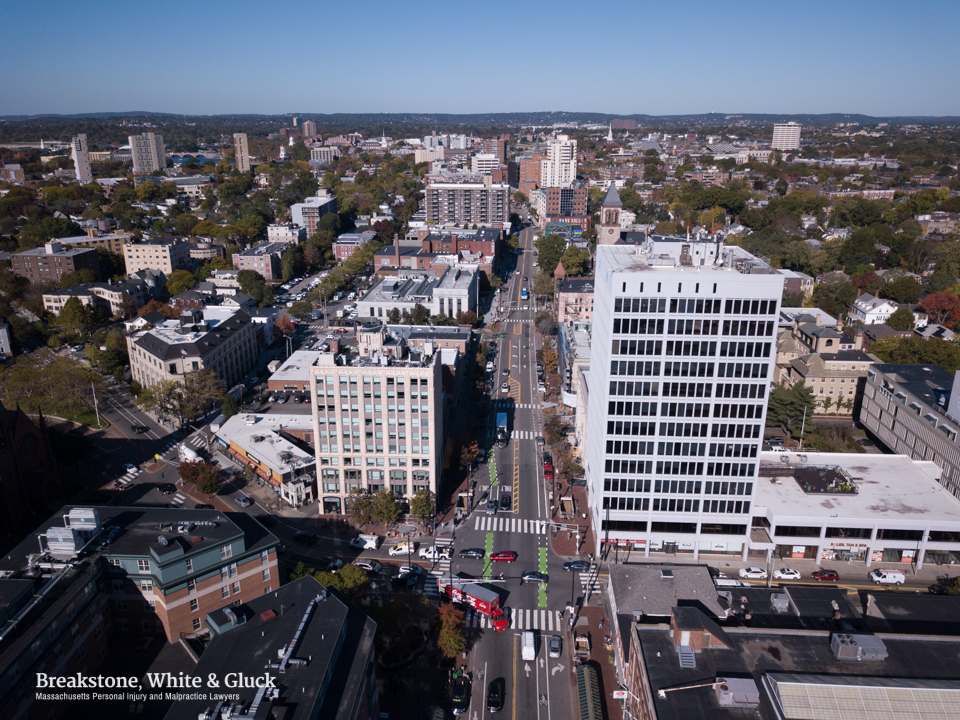
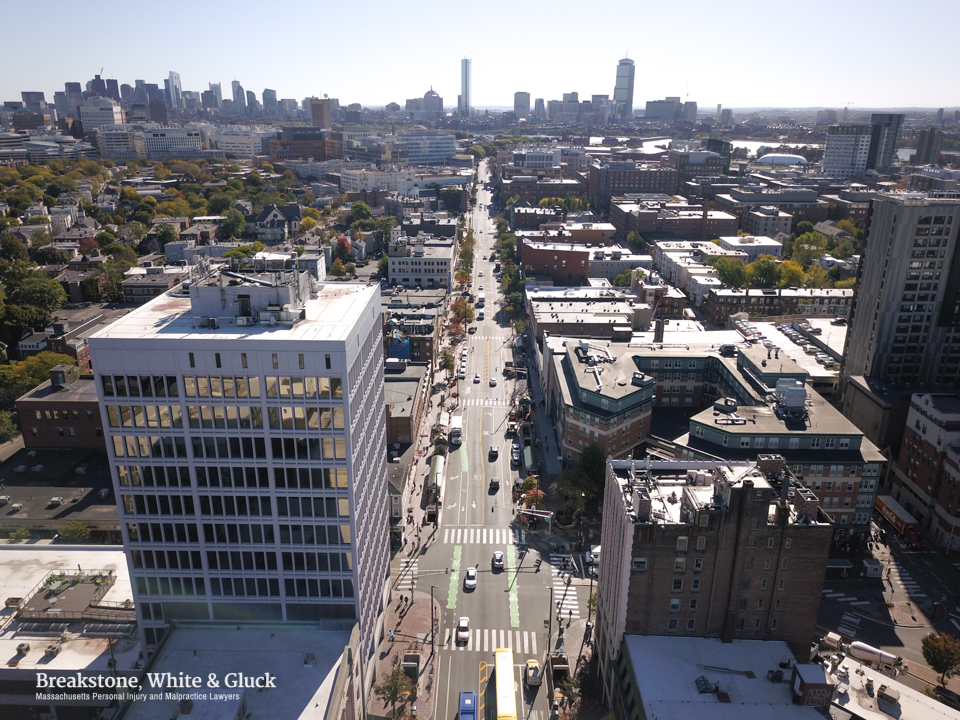
Safety for pedestrians and cyclists is a top concern in Central Square in Cambridge.
Central Square is located around the intersection of Prospect Street, Massachusetts Avenue and Western Avenue in Cambridge. This area is a commuter hub; the Central Square MBTA subway station and bus stop are located here, near Cambridge City Hall. The state of Massachusetts has designated Central Square as an official cultural district, for its mix of theater and arts, restaurants and history. The NECCO building was long part of that history, but these days, 250 Massachusetts Avenue is now the Novartis’ global headquarters. The Cambridge YMCA is there and MIT is nearby.
Over the years, there have been numerous pedestrian and bicycle accidents in Central Square. Central Square was the #1 location for bike crashes in Massachusetts from 2005-2014, according to the Massachusetts Department of Transportation (MassDOT). It was the 5th highest pedestrian crash location. The City of Cambridge has worked to improve safety by improving crosswalks and adding bike lanes across the city. In December 2016, new bike lanes were laid down in Central Square, northbound on Massachusetts Avenue between Sydney and Douglass streets.
We recently went up over Central Square. Please take a look and share this blog with anyone who travels in this area, whether they walk, bike, drive or travel by Uber. From a different angle, we hope you gain a better understanding of the traffic in this area.
We also recently visited Inman Square.
About Breakstone, White & Gluck
At Breakstone, White & Gluck, our Boston personal injury lawyers fight for justice for those who have been seriously injured by the negligence and wrongdoing of others. Our lawyers have been recognized as among the top personal injury and medical malpractice lawyers in Massachusetts and New England. We are committed to protecting cyclists through our Project KidSafe campaign, which has donated over 15,000 helmets to children in the first 5 years. If you have been injured, learn your rights. Contact us today at 800-379-1244 or 617-723-7676 or use our contact form.
Aerial Photos of Cambridge’s Inman Square Show Safety Improvements for Cyclists
We had a fun opportunity to see Inman Square from up high a few weeks ago. Here are some of our photos:
- Inman Square in Cambridge. The Inman Square Fire House – or Cambridge Fire Department Station 5 – is on the left. Central Square is up ahead.
- Looking down Hampshire Street from Inman Square. You can see a few birds made our photo, as did a driver in the bike lane. Not where he is supposed to be. Drivers, please stay out of the bike lane!
- Up high over Inman Square in Cambridge.
- Looking over Inman Square toward the City of Boston.
- Directly over the intersection of Hampshire and Cambridge streets.
The City of Cambridge has worked to improve safety for cyclists in Inman Square, recently adding new separated bike lanes on both sides of Cambridge Street, from Inman Square to Quincy Street, which approaches Harvard Square. This is .7 miles of new bike lanes with paint, flex posts and other temporary materials to help cyclists stand out. And the new lanes pass Cambridge Rindge & Latin, which serves more than 1,900 high school students. Last fall, the city also banned drivers from making certain left turns in Inman Square, after many years of bike crashes followed by a fatal bike accident last June.
Hampshire and Cambridge streets cross at Inman Square. In our photos, you can see a stretch of green bike lanes on Hampshire Street. These intersect with the new bike lanes on Cambridge Street, which are less visible, but they are there.
All the bike lanes look great. We hope they make the commute safer for cyclists and everyone on the roads.
More About Inman Square
Inman Square, known for its distinctive shops and restaurants, comes together around Hampshire and Cambridge streets. But there are several other streets that also meet here, making for a complicated intersection. These include Antrium Street, Fayette Street, Inman Street and Springfield Street. Prospect Street is at the other side of the triangle and the Somerville city line is nearby.
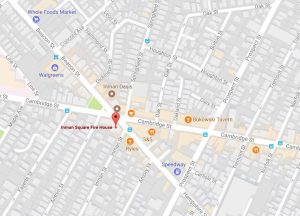
Inman Square on Google Maps.
The Inman Square Fire House – or Cambridge Fire Department Station 5 – and the Mayor Alfred E. Vellucci Community Plaza are two Inman Square landmarks. There are also several banks here and a number of businesses named after the neighborhood: Inman Pharmacy, Inman Square Laundromat, Inman Square Hardware, as well as Inman Square Apartments. Restaurants include City Girl Cafe, 1369 Coffee House and Punjabi Dhaba.
This area is not served by a MBTA subway station, so you have to drive, take the bus, walk or bike. The Central Square MBTA is just over a half mile away and Harvard Square is a mile. Because of this, many choose to bike. If you don’t have a bike, Inman Square has a Hubway bike share station.
Cycling is not allowed on the sidewalk (as in most business areas in Massachusetts, unless it is posted otherwise). But riding on the street is not easy. There have been numerous bicycle crashes here over the years. So many that Inman Square has been named the second top bike crash location in Massachusetts (Source: 2014 Top Crash Locations from MassDOT, dated August 2016). Only Central Square in Cambridge sees more bike accidents. In fact, nine out of the 10 top bike crash locations in Massachusetts are in Cambridge and Somerville, which is why the new protected bike lanes are so important.
After years of bike accidents in Inman Square, there was a fatal bike crash in June 2016, when a cyclist was tragically killed right at Hampshire and Cambridge streets. Amanda Phillips, just 27 years old, collided with a Jeep door which was left open. She was then struck by a landscaping truck. A few months later, another cyclist was killed by a truck crash in Porter Square, raising questions about safety there.
Back in Inman Square, the city banned motor vehicle traffic from making left-hand turns on key streets in October 2016. Motorists were banned from turning left from Hampshire Street onto Cambridge Street – and vice versa. They were also prohibited from turning left on Cambridge Street onto Antrium Street southbound. The city has strictly enforced the ban. The Cambridge Police Department issued more than 200 tickets in the first month of the new restriction; 133 drivers alone were ticketed within a 15-day period.
If you haven’t visited Cambridge in a while, you can expect to see a few changes next time you do. Cambridge Street is just one area with new bicycle lanes. For those who live or work in Inman Square – or commute through – you already know these streets well and have seen the changes firsthand. But please take a look at our photos and share them with others. The more drivers, cyclists and pedestrians understand about this intersection, the more prepared they will be to follow traffic rules, which will reduce bike crashes and pedestrian accidents.
About Breakstone, White & Gluck
Breakstone, White & Gluck is a Boston law firm specializing in personal injury. For more than 25 years, we have committed to supporting cyclists and improving safety conditions in Massachusetts. We support numerous bicycle clubs and advocacy groups, including MassBike, Boston Cyclists Union, Charles River Wheelmen, New England Mountain Bike Association (NEMBA) and the Northeast Bicycle Club (NEBC).In 2017, we finished the fifth year of our Project KidSafe campaign, which has donated more than 15,000 bicycle helmets to children. Wearing a helmet is required by law for cyclists 16 and under in Massachusetts, but we want to encourage every cyclist to wear a helmet every time they ride. We have over 40 community partners helping us send out that message, including in Cambridge and Somerville.
In Cambridge, we partner with the Cambridge Police Department, CYCLE Kids and the Windsor Street Care Center to make donations each year. In Somerville, we have long partnered with Kiwanis Club of Somerville, CYCLE Kids and Somerville Public Schools, Groundwork Somerville and Shift Bicycle Community Collective.
Learn more Breakstone, White & Gluck
Visit our website to learn more about our support for cyclists, our Project KidSafe campaign or to meet our lawyers.
New Protected Bike Lanes for Inman Square in Cambridge
Cyclists riding through Inman Square now have a safer ride home. The City of Cambridge has recently installed separated bicycle lanes on Cambridge Street, from Inman Square to Quincy Street. The lanes are clearly marked, with flex posts creating a barrier between cyclists and drivers.
These lanes should have many benefits. We hope one is to reduce dooring crashes, such as the one that killed Amanda Phillips in Inman Square in 2016. The 27-year-old Somerville resident was riding a bike and collided into a Jeep door which was left open. The impact pushed her into the travel lane, where she was hit and killed by a landscaping truck. The accident happened near Hampshire and Cambridge streets.
Dooring has been against the law in Massachusetts since 2009. M.G.L. c.90 § 14 states, “no person shall open a door on a motor vehicle unless it is reasonably safe to do so without interfering with the movement of other traffic, including bicyclists and pedestrians.”
Cambridge Police Department and Breakstone, White & Gluck’s Project KidSafe Campaign Give Away Free Bicycle Helmets to Children at Rindge Tower Apartments
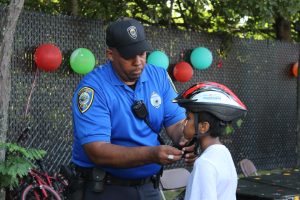
Thank you to the Cambridge Police Department for fitting bike helmets for the kids at Rindge Tower Apartments. Breakstone, White & Gluck donated the helmets as part of our Project KidSafe campaign.
Just-A-Start, a community development corporation serving Cambridge, treated families at the Rindge Tower Apartments to a Community BBQ with all the best fixings of summer last week. From hot dogs, hamburgers and snow cones to bouncy houses, music and conga lines, the gathering drew more than 150 people from the 273-unit apartment building near Alewife Station.
The Cambridge Police Department participated, distributing safety materials and free bicycle helmets from Breakstone, White & Gluck’s Project KidSafe campaign. Officers distributed and fitted over 80 helmets for children.
“Our thanks to the Cambridge Police Department and the attorneys of Breakstone, White & Gluck for providing the bike helmets,” said Nancy Porcaro, Just-A-Start’s community coordinator. “We were touched by the donation and I feel it was one of the most important components to our annual event. The helmets were a big hit with the families and will go a long way toward protecting the children on bikes.”
About Breakstone, White & Gluck and Project KidSafe
Breakstone, White & Gluck, a personal injury and medical malpractice law firm based in Boston, was founded by Marc L. Breakstone, David W. White and Ronald E. Gluck in 1992. In 2017, we celebrated our 25th anniversary serving our clients.
We founded our Project KidSafe campaign in 2013 with a goal of keeping children safe on bikes. Since then, we have donated more than 15,000 bicycle helmets in Boston, Cambridge, Somerville and across Massachusetts. Our goal is to encourage children to wear helmets every time they ride to prevent head injuries from bicycle accidents or falls. Under Massachusetts law, cyclists under 17 years old are required to wear helmets which meet the Consumer Product Safety Commission standard. But we hope children reached by our Project KidSafe campaign will make helmets a life-long habit.
This is the second year Breakstone, White & Gluck and the Cambridge Police Department have partnered together to promote bicycle safety.
6 Tips for Boston and Cambridge College Students Who Are Moving Into Off-Campus Housing

Many college students heading to Boston will be living in off-campus housing. The attorneys of Breakstone, White & Gluck share safety tips and resources.
College students are just days away from starting the Fall semester. In Boston and Cambridge, we urge students to make time for an extra lesson on safe housing. Make sure you understand your rights as a tenant and your landlord’s responsibility to maintain a safe property.
Boston and Cambridge have more than 40 colleges and universities. Because of a shortage in dorm space, many students end up in off-campus housing. Unfortunately, some find themselves dealing with unresponsive landlords who want to collect rent, without doing the work to maintain a property. If you are in this situation, it is important to remember that if a landlord is charging you rent, you have the right to a safe and sanitary apartment.
When a landlord is unresponsive and negligent, it can lead to many problems. It can result in sanitary issues, such as mold, rodents or a bug infestations. It can also lead to broken equipment (for instance, a broken smoke alarm, which needs to be addressed right away).
Porch collapses and fires are two of the most common and serious types of premises liability accidents. As a result of landlord negligence, over the past 10 years, five college students have died in off-campus fires in Massachusetts, according to the state’s website.
Project KidSafe Bike Helmet Donations: Dedham Bike Rodeo, Mattapan on Wheels and Windsor Street Care Center in Cambridge
 We want to share a few photos from our Project KidSafe campaign.
We want to share a few photos from our Project KidSafe campaign.
Dedham Bike Rodeo. Breakstone, White & Gluck was pleased to donate 120 Project KidSafe bike helmets to the Dedham Bike Rodeo on July 26. Attorney David W. White participated in the event, fitting helmets for children who needed one. We always enjoy this event because we get a chance to talk to children and parents about bike helmets and bike safety. It was one of the first events we donated helmets to in 2013, the year we began our Project KidSafe campaign. The rodeo is organized by the Dedham Police Department and the Dedham Parks and Recreation Department.
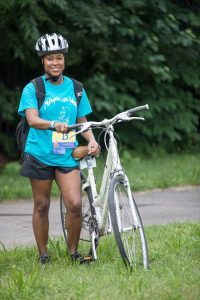
Mattapan on Wheels. Breakstone, White & Gluck also donated helmets to cyclists at the 7th Annual Mattapan on Wheels event on July 22. We are told 130 cyclists took to the Neponset Trail to raise funds for a youth bike summit and many had no helmet or needed a new one. Participants could choose their destination and ride along the trail to Pope John Paul II Park, Carson Beach or Castle Island. This was the first time we donated helmets to this event and we are told every helmet was put to use.

Windsor Street Care Center. Breakstone, White & Gluck also donated 150 bike helmets to the Windsor Street Care Center, which is part of the Cambridge Healthcare Alliance. The medical staff have been giving helmets away throughout the summer to children who need one. This is the third year we have made this donation.
About Breakstone, White & Gluck and our Project KidSafe Campaign
Breakstone, White & Gluck is proud to support cyclists through our Project KidSafe campaign. Since 2013, our attorneys have donated over 10,000 bicycle helmets to children in Boston and across Massachusetts. Our goal is to encourage children to wear helmets every time they ride to prevent head injuries on bicycles. To learn more about our campaign, visit www.bwglaw.com/project-kidsafe/.
Photo Credits:
- Mattapan on Wheels: Photo taken by Donrick Pond. Courtesy of Mattapan Food and Fitness Coalition Vigorous Youth Facebook page.
- Windsor Street Care Center, Cambridge Health Alliance Facebook page.
Slow Down! Boston, Cambridge and Other Cities Have Dropped Speeds to 25 MPH
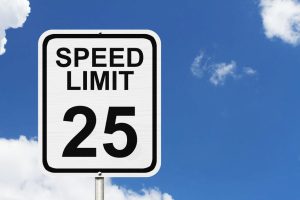 Over the past year, Boston, Cambridge and several other communities have lowered default speed limits from 30 to 25 mph, with a goal of creating safer streets for pedestrians and cyclists. Now it is Quincy’s turn.
Over the past year, Boston, Cambridge and several other communities have lowered default speed limits from 30 to 25 mph, with a goal of creating safer streets for pedestrians and cyclists. Now it is Quincy’s turn.
Last week, the Quincy City Council passed a measure establishing a speed limit of 25 mph, unless another speed limit is posted. The previous speed limit had been 30 mph. Once Mayor Thomas P. Koch signs the new law, officials will decide on an effective date.
In January 2017, the City of Boston dropped its default speed limit from 30 to 25 mph.
Lowering the speed limit was a key part of the Vision Zero Boston campaign, which was launched by Mayor Marty Walsh in 2015. The goal is to end traffic deaths and serious injuries in the City of Boston by 2030, through a combination of efforts, such as reducing speeds, eliminating distracted driving, and improving infrastructure for safer riding, walking and cycling.
While lowering speed limits was a critical step, the City of Boston was unable to act right away.
First, the city had to obtain approval from the state Legislature and Gov. Charlie Baker. Baker signed the Municipal Modernized bill in August 2016, which gave Boston, as well as cities and towns across the state, authority to reduce the default speed limit on local roads.
So far, these communities have reduced speed limits:
- Boston
- Cambridge
- Somerville
- Arlington
- Newton
- Randolph
- Scituate
- Quincy (approved by City Council)
Source: The Boston Globe.
Benefits to Slower Speed Limits
There is strong evidence that slower traffic means safer streets. An excellent example is New York City. In 2014, the city lowered speed limits to 25 mph on 90 percent of its streets. Over three years, traffic fatalities have decreased 23 percent and fell to the lowest number in the city’s history in 2016.
Boston city officials say that when crashes happen, faster vehicles are likely to cause the most serious injuries and fatalities. According to the City of Boston website, at 20 mph, there is a 17 percent likelihood that someone will be seriously injured or killed. At 40 mph, there is a 79 percent likelihood. Slower vehicles can be stopped more quickly, and the slower speeds allow for longer reaction times.
Read More


